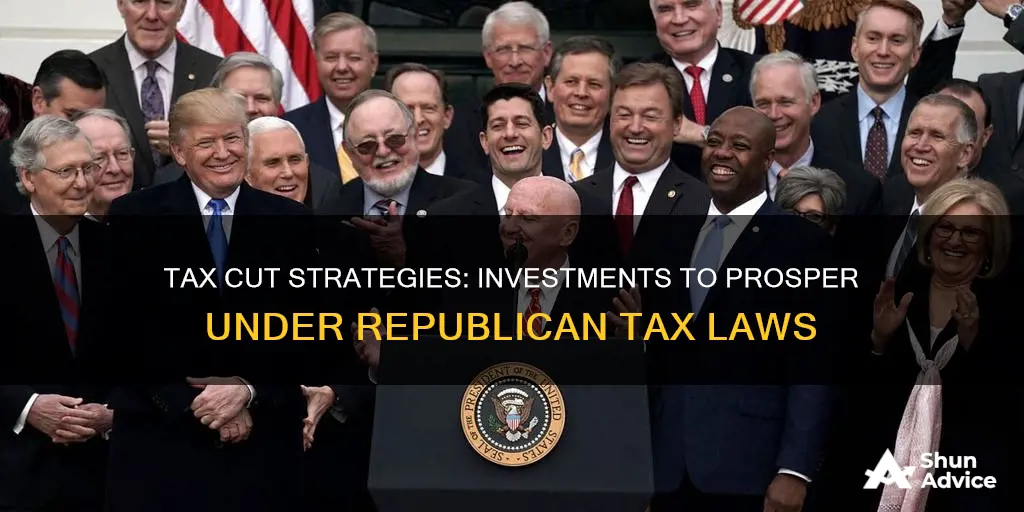
The 2017 Tax Cuts and Jobs Act, signed into law by President Donald Trump, was the largest tax code overhaul in three decades. The reform, which impacted both taxpayers and business owners, introduced a single flat corporate tax rate of 21% and cut tax rates for people of all income brackets. While the legislation was pitched as a way to boost investment and benefit middle-class families, it has been criticised for disproportionately benefiting the wealthy and profitable corporations, adding to the national debt.
The tax cuts, which are set to expire in 2025, have been criticised by President Biden, who has proposed an alternative economic vision that involves cutting taxes for working people and families with children, while ensuring that large corporations and the super-wealthy pay their fair share.
What You'll Learn

Corporate tax rate cut from 35% to 21%
The Tax Cuts and Jobs Act (TCJA) was signed into law by President Donald Trump in 2017 and took effect on January 1, 2018. The legislation was the largest overhaul of the tax code in three decades, impacting both taxpayers and business owners.
One of the key components of the TCJA was the reduction in the federal corporate tax rate from 35% to 21%. This change brought the US corporate tax rate closer to the average for most other OECD countries. The new rate was a flat tax, eliminating the previous graduated corporate rate schedule.
In addition to lowering the corporate tax rate, the TCJA also repealed the corporate alternative minimum tax. This tax reform was intended to reduce the incentives for corporate inversions, where companies shift their tax base to low- or no-tax jurisdictions, often through mergers with foreign firms.
The reduction in the corporate tax rate was expected to benefit shareholders, who tend to be higher earners. However, the individual tax cuts implemented by the TCJA were temporary and set to expire in 2025, after which the majority of taxpayers were projected to face a tax increase.
Overall, the TCJA made significant changes to the corporate income tax and had a substantial impact on businesses and the economy.
Smart Strategies for Investing $100K for Retirement
You may want to see also

Child Tax Credit increase
The Child Tax Credit (CTC) is a tax credit available to families with children. The amount of the credit is determined by the number of children in the family and the family's income. Under the Trump Administration's 2017 tax cuts, the CTC was set at $2,000 per child under the age of 17. However, this amount was temporarily increased to $3,000 (or $3,600 for children under 6) by the American Rescue Plan in 2021. This change had a significant impact on reducing child poverty, with millions of families receiving much-needed relief during the pandemic.
Unfortunately, this expansion of the CTC was not extended beyond 2021 due to opposition from Republicans and some Democrats. As a result, the child poverty rate more than doubled in 2022, affecting over five million children. In 2024, there was an attempt to pass a bill that would modestly expand the CTC until the 2017 tax package expires in 2025. The bill, known as the Wyden-Smith bill, proposed increasing credits for children from families with incomes too low to claim the full amount and indexing the credit to inflation for 2024 and 2025. It also included business tax breaks, which were key to gaining Republican support.
Despite receiving overwhelming bipartisan support in the House, with a vote of 357-70, the bill faced opposition in the Senate from key Republican senators, who demanded significant changes. One of the main issues was the "look-back" policy, which allowed taxpayers to use their previous year's income to receive a higher credit. Republican senators, led by Mike Crapo, argued that this policy weakened the work requirement and would create entitlement spending that would generate higher deficits. They also expressed concerns about the impact on corporations, stating that the bill would "say no to those who are the small businesses and say yes to a [Donald] Trump presidential campaign that's going to be based on being more sympathetic to billionaires' tax needs."
As a result of the opposition, the bill stalled in the Senate, and there was no progress toward rectifying the reduction in the CTC. This inaction had a significant impact on families, with millions being denied much-needed relief. It is estimated that in the first year alone, an expanded credit would have benefited 16 million children in low-income families. The average benefit for these families would have been at least $630, with 40% of low-income families receiving $1,000 or more.
Overall, the failure to extend or further expand the CTC has disproportionately affected low-income families and children, particularly those in poverty. While there were attempts to address this issue through the Wyden-Smith bill, the opposition from Republican senators prioritized corporate interests over the needs of vulnerable families.
Investing in Corporations: Why?
You may want to see also

Earned Income Tax Credit increase
The Earned Income Tax Credit (EITC) is a federal tax credit for working people with low to moderate incomes. It boosts the incomes of low-wage workers while offsetting federal payroll and income taxes.
The EITC is one of the federal government's largest refundable tax credits for low to moderate-income families. The credit is refundable, meaning that if the value of the credit exceeds the amount of federal income tax owed by a low-paid worker, the worker receives the difference in the form of a refund.
In 2020, 25 million working families and individuals received the EITC. In 2021, the American Rescue Plan Act temporarily expanded the EITC for workers without children, raising the maximum from $540 to $1,500 and increasing the income cap from $16,000 to $21,000 for single adults ($27,000 for married couples). The Rescue Plan also expanded the age range of eligible working adults without children to include younger adults aged 19-24 and people aged 65 and older.
For the 2023 tax year, working families with children and annual incomes below $46,600 to $63,400 (depending on marital status and number of dependent children) may be eligible for the federal EITC. Working adults who aren't raising children at home and had incomes below $17,640 if unmarried ($24,210 for a married couple) in 2023 can receive a small EITC.
The amount of the EITC depends on a recipient's income, marital status, and number of children. The EITC begins with the first dollar of earned income and rises with earned income until it reaches a maximum level, after which it phases out at higher income levels.
Some US states have established their own EITCs to supplement the federal credit. For example, Michigan's EITC was set at 10% of the Federal credit in 2006 and increased to 20% in 2009. In 2023, a bill was proposed to increase Michigan's EITC from 6% to 30%.
Fees and the Long Game: Understanding the Impact on Retirement Savings
You may want to see also

Affordable Care Act (ACA) premium tax credits
The Premium Tax Credit (PTC) is a refundable tax credit that helps eligible individuals and families with low to moderate incomes afford health insurance purchased through the Health Insurance Marketplace. The size of the PTC is based on a sliding scale, with those who have lower incomes receiving a larger credit to help cover the cost of their insurance.
To be eligible for the PTC, you must meet the following requirements:
- Have a household income that falls within a certain range. For the 2021 tax year, if a taxpayer or their spouse received unemployment compensation for any week, their income is treated as no greater than 133% of the federal poverty line. For tax years 2021-2025, eligibility was expanded to include taxpayers with a household income above 400% of the federal poverty line.
- Do not file a tax return using the status of 'Married Filing Separately'. An exception to this rule allows certain victims of domestic abuse and spousal abandonment to claim the credit using this filing status.
- Cannot be claimed as a dependent by another person.
- In the same month, you or a family member must:
- Have health insurance coverage through the Health Insurance Marketplace, with the share of the premium not covered by advance credit payments paid by the due date of your return.
- Be unable to get affordable coverage through an eligible employer-sponsored plan that provides minimum value.
- Be ineligible for coverage through a government program like Medicaid, Medicare, CHIP, or TRICARE.
When enrolling in Marketplace insurance, individuals can choose to have the Marketplace compute an estimated credit to be paid to the insurance company to lower monthly premiums (advance credit payments or APTC). Alternatively, they can choose to receive the full benefit of the credit when filing their tax return for the year. If advance credit payments are chosen, the amount paid in advance will be reconciled with the actual credit computed on the tax return.
For tax years other than 2020, if an individual receives the benefit of advance credit payments in any amount, or plans to claim the PTC, they must file a federal income tax return and attach Form 8962, Premium Tax Credit (PTC). Filing a return to reconcile the credit amount with advance credit payments is also required if an individual does not usually need to file a return.
The American Rescue Plan Act of 2021 (ARPA) suspended the requirement to repay excess advance payments of the PTC for the 2020 tax year.
Young Investors: Why the Apathy?
You may want to see also

Adoption Tax Credit expansion
The Adoption Tax Credit is a one-time tax refund available for parents who adopt from foster care, internationally, or through private domestic adoptions. The credit can be applied over the course of five years and was $13,570 in 2017. An adoption can cost as much as $40,000 if a family uses a private agency.
The Adoption Tax Credit Working Group has stated that the elimination of the credit in the House Republican tax bill goes against the GOP's "pro-life" platform. The group has also said that the bill, "does exactly the opposite by cutting a credit designed to help American families adopt children."
The Biden Administration's plan proposes improving and expanding eligibility for the Adoption Tax Credit. This would reduce taxes by thousands of dollars on average for 70,000 families adopting a child, lowering the financial burden on low- and moderate-income families pursuing adoption, as well as for families who opt for legal guardianship.
Ratios Reveal: Investing Insights
You may want to see also
Frequently asked questions
The main criticisms of the Republican tax cuts are that they disproportionately benefit the wealthy and profitable corporations, severely reducing federal revenues.
The key features of the Republican tax cuts are the reduction in income tax rates for people in all brackets, the cut in corporate tax rates, and the increase in the child tax credit.
The Republican tax cuts have added trillions of dollars to the national debt. The precise figure depends on the time period under consideration, but one source states that the Bush and Trump tax cuts have added $10 trillion to the debt since their enactment.
The Republican tax cuts were expected to boost investment by increasing wages, expanding factories, and creating jobs. However, the impact on investment has been mixed. While stock prices and corporate dividends have increased, corporate investment is now at lower levels than before the tax cuts, according to the Commerce Department.







